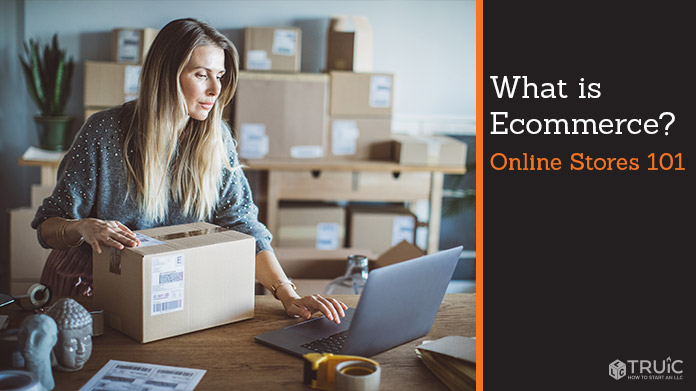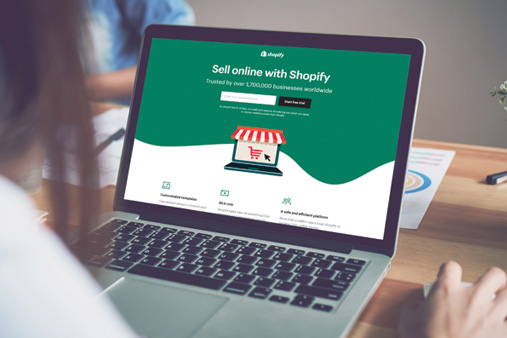What Is an Ecommerce Business? Definition, Benefits, and Examples
The ecommerce industry has seen consistent growth over the past few years. While most people simply found online shopping convenient, many businesses now consider it a necessity. But, exactly what is ecommerce?
If you’re thinking of starting an ecommerce business, you’ll need to know the definition of ecommerce, the difference between ecommerce and ebusiness, and what kind of ecommerce store might best suit your business. This article will help you better understand the ecommerce business world to learn if it’s the right fit for you.
Ready to build an ecommerce store? Be sure to read our How to Build an Ecommerce Website tutorial.

What Is Ecommerce?
Ecommerce, or electronic commerce, refers to buying and selling goods and services online. Some businesses only sell their offerings online while others use ecommerce to supplement their brick-and-mortar stores.
While you probably already know about ecommerce giants like Amazon, Etsy, and eBay, smaller companies like paintbynumbersonline and StationeryXpress also found success in this industry.
This article will dive into everything you need to know about how the history and trajectory of ecommerce. Use the guide below to easily find any information you might be looking for.
Skip Ahead:
The History of Ecommerce
Ecommerce started in 1994 when Phil Brandenberger made the world’s first encryption-enabled online purchase. Since then, the industry continued to grow at an unprecedented rate and now represents one of the world’s fastest-growing markets.
As you’ve likely seen, people spell ecommerce in a variety of ways, including “ecommerce,” “eCommerce,” “e-commerce,” “Ecommerce,” “E Commerce,” and “E-Commerce.” While the correct spelling remains a subject of great debate, “ecommerce” and “e-commerce” represent the most common versions.
Types of Ecommerce
The main three types of ecommerce include business-to-business (B2B), business-to-consumer (B2C), and consumer-to-consumer (C2C). But, another common type of ecommerce — consumer-to-business (C2B) — emerged in the past few years.
B2B Ecommerce
When a business sells its goods or services to another business online, that’s B2B ecommerce. For example, a medical supply company selling its products to a hospital or doctor’s office falls into this category.
B2C Ecommerce
When a business sells its goods or services to consumers online, that’s B2C ecommerce. For example, a retail clothing store selling its products directly to customers online represents this form of ecommerce.
C2C Ecommerce
If a consumer sells something online to another consumer, that’s C2C ecommerce. A consumer selling used CDs on eBay provides an example of this type of ecommerce.
C2B Ecommerce
If a consumer sells their own products or services to a business online, that’s C2C ecommerce. For example, a freelance web developer might design a new website for a local business.
Ecommerce Examples
Each type of ecommerce includes thousands of small, medium, and large businesses, which you can classify according to a number of different groups.
Retail Ecommerce Businesses
Retail ecommerce businesses can use the B2B, B2C, C2C, or C2B models, depending on the type of sale they make. Examples of retail ecommerce businesses include Macy’s online, Threadly, Amazon, IKEA, Harbour House Crabs, and Flora Fine Foods.
Dropshipping Ecommerce Businesses
A subset of retail ecommerce, dropshipping refers to ecommerce businesses that don’t maintain their own stock. In a dropshipping sale, the retailer will accept an order and pass it along to a third party who then ships the product to the customer. You may connect with dropshipping ecommerce businesses through Amazon, Wish, Newegg, Walmart, and Overstock.com.
Wholesale Ecommerce Businesses
Wholesale ecommerce businesses typically fall within the realm of B2B ecommerce. Some examples include Costco Wholesale Corporation, Amazon Business, Michaels, Importers Direct Wholesale Company, Sysco, and Sarasota Wholesale Tile Supply.
Crowdfunding Ecommerce Businesses
Crowdfunding websites specialize in helping businesses and consumers raise funds for a specific project or cause. These websites apply a platform fee (a fee to use the site), which typically ranges from five percent to more than 10 percent. Examples of crowdfunding ecommerce sites include Kickstarter, GoFundMe, Indiegogo, Causes, Patreon, and LendingClub.
Subscription Ecommerce Businesses
Subscription ecommerce websites typically use the B2C model and involve the retailer (or dropshipper) sending products to the consumer at agreed-upon intervals. Examples of subscription ecommerce sites include Amazon (it offers some products on a subscription basis), Birchbox, Stitch Fix, Dollar Shave Club, BarkBox, Wine of the Month Club, and The Gourmet Cheese of the Month Club.
Services Ecommerce Businesses
Services ecommerce websites solely focus on selling services to consumers and businesses. Examples of services ecommerce sites include tax preparation services, online legal advisors, resume and cover letter services, online tutoring, and online consulting services.
Ecommerce Pros and Cons
Ecommerce businesses come with several distinct advantages and disadvantages. If you’re thinking about starting your own ecommerce business, carefully consider each of these points.
Ecommerce Pros
- It’s convenient. Online businesses can operate 24/7 every day of the year.
- It enables a larger selection. These businesses often can offer a wider range of products than typical brick-and-mortar stores.
- It has lower overhead costs. Ecommerce businesses don’t have to rent office space and, if they use dropshipping, don’t have to obtain warehouse space.
- It can make it easier to reach new customers. Online businesses often can market their products throughout the country, if not the world.
Ecommerce Cons
- It lacks face-to-face customer service. Because they conduct all their business via the internet, ecommerce companies may find it difficult to learn how to deliver excellent customer service online.
- It doesn’t provide instant gratification. Customers who find it difficult to wait for product shipments may prefer brick-and-mortar stores for some products so they can get those items sooner.
- It can complicate product displays. Properly showcasing products and services online can sometimes prove difficult. Businesses must carefully write product descriptions and take high-quality photos to ensure they accurately represent the products or services they offer.
- It’s vulnerable to website issues. If your ecommerce website goes down, suffers a cyberattack, or becomes otherwise unavailable, you’ll lose the ability to sell your products or services.
How To Get Started With Ecommerce
If you’re ready to start your own ecommerce website, you’ll need to follow several key steps. The most difficult part of the process involves researching your business model, developing your brand, and choosing the right product or service to sell. As you develop your ecommerce business plan, consider these seven steps that all ecommerce entrepreneurs must take to properly set up their business.
Step 1: Choose Your Business Model
Deciding what you want to sell and to whom represents the first step to starting your own ecommerce business. You should choose the best ecommerce type from among the B2B, B2C, C2C, and C2B models. Once you determine the right business model for your new venture, you’ll need to narrow it down even further. Review the ecommerce examples to get a better feel for the types of ecommerce businesses you can open.
Step 2: Choose Your Niche
While you aren’t required to choose an ecommerce niche, we highly recommend doing so. Very few ecommerce sites have the chance to become the next Amazon or eBay. Choosing a moderately competitive market in which your business can provide a distinct value may represent your best bet.
Amazon customer service and eBay customer service are exemplary and go out of their way to help customers beyond what most other companies do. This is one contributing factor to their success. Remember this when starting your company.
Step 3: Create Audience Personas
Another essential part of starting an ecommerce business involves developing audience personas and clarifying your target market. Creating profiles for your target audience(s) will help you develop your business website and marketing materials in a way that will engage them more effectively.
Step 4: Legally Form Your Business
The rules for starting a business vary by state. But, all businesses must submit both state and federal documentation in order to legally operate. To learn more about the rules and regulations that apply to your state, visit our How To Start a Business guide and select your state from the drop-down menu.
Step 5: Develop Your Brand
Before you build your ecommerce site and start selling goods or services online, you must first conduct some research and develop your brand. For example, you’ll need to select a name for your online store, secure a domain name for your website, and develop a brand logo and color scheme, among other tasks.
Step 6: Build Your Ecommerce Website
When you’re ready to create your ecommerce site, you must decide if you want to build it yourself or hire someone to build it for you. Read our How To Build a Business Website guide to learn more about the different options.
Looking for information on how to build an ecommerce store on a budget? Check out our Best Cheap Ecommerce Builders review.
Step 7: Market Your Goods or Services
The last step involves marketing your goods or services. Our Business Planning Guide and Business Plan Generator will help teach you the principles you need to know to market your business effectively.
Ecommerce FAQ
Is ecommerce safe?
Yes, ecommerce is safe for both business owners and customers. The introduction of encryption measures like secure sockets layer (SSL) certificates and hypertext transfer protocol secure (HTTPS) made internet shopping more secure than ever before. While ecommerce sites remain prime targets for cyberattacks, many website hosting providers and website builders offer additional protections.
What are ecommerce platforms?
Ecommerce platforms include software applications designed specifically to create online stores. Some of the most popular platforms include BigCommerce and Shopify.


